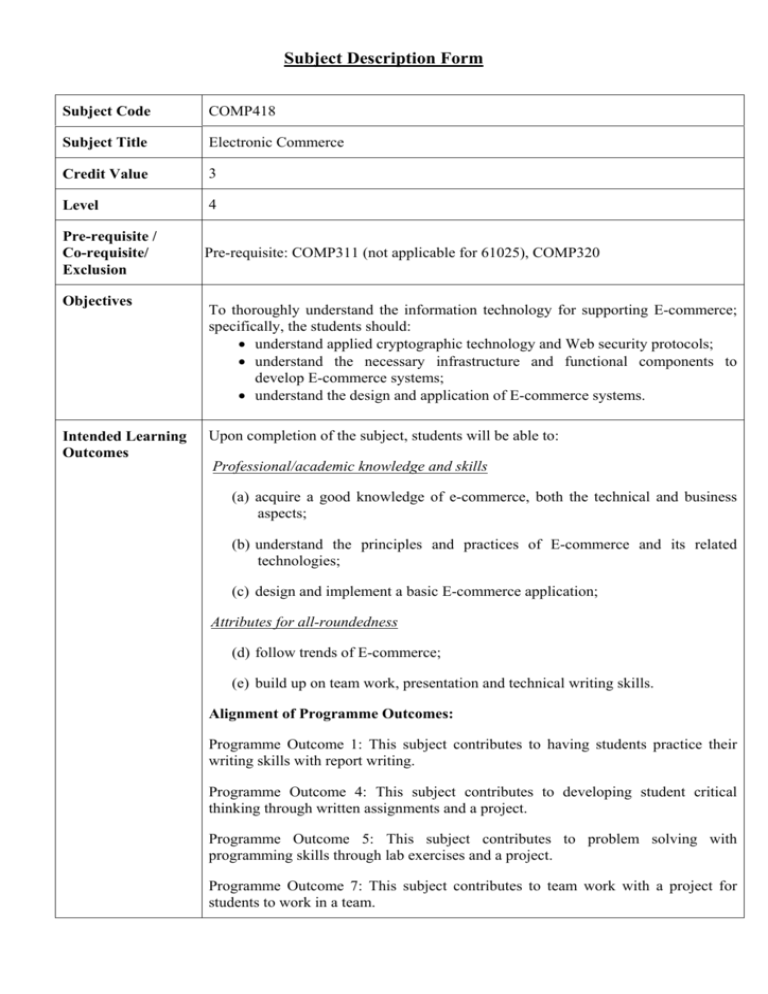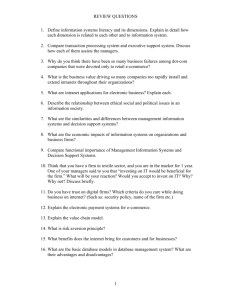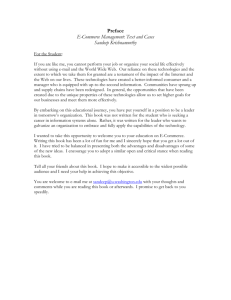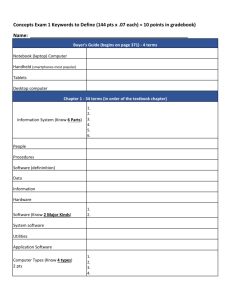COMP418 Electronic Commerce
advertisement

Subject Description Form Subject Code COMP418 Subject Title Electronic Commerce Credit Value 3 Level 4 Pre-requisite / Co-requisite/ Exclusion Pre-requisite: COMP311 (not applicable for 61025), COMP320 Objectives Intended Learning Outcomes To thoroughly understand the information technology for supporting E-commerce; specifically, the students should: understand applied cryptographic technology and Web security protocols; understand the necessary infrastructure and functional components to develop E-commerce systems; understand the design and application of E-commerce systems. Upon completion of the subject, students will be able to: Professional/academic knowledge and skills (a) acquire a good knowledge of e-commerce, both the technical and business aspects; (b) understand the principles and practices of E-commerce and its related technologies; (c) design and implement a basic E-commerce application; Attributes for all-roundedness (d) follow trends of E-commerce; (e) build up on team work, presentation and technical writing skills. Alignment of Programme Outcomes: Programme Outcome 1: This subject contributes to having students practice their writing skills with report writing. Programme Outcome 4: This subject contributes to developing student critical thinking through written assignments and a project. Programme Outcome 5: This subject contributes to problem solving with programming skills through lab exercises and a project. Programme Outcome 7: This subject contributes to team work with a project for students to work in a team. Subject Synopsis/ Indicative Syllabus Topic 1. Introduction to E-commerce E-commerce fundamentals; different types of E-commerce; major components; business models; business issues. 2. Web system Internet basics; Web model; Web system; Hypertext Transfer Protocol (HTTP); Web programming. 3. Cryptography and Internet security Security requirements; basic cryptography; encryption methods; public key encryption; message digest; message authentication; digital signature; digital certificate; IPSec; firewalls; SSL. 4. Internet payment systems Credit card payment (e.g., SET protocol); E-cash; E-check; Internet payment services; smart card. 5. E-commerce applications and advanced topics Various E-commerce applications; case studies; auctions; advanced E-commerce systems. Laboratory Experiment: Laboratory exercises on an E-commerce application. Case Study: E-commerce applications. Teaching/Learning Methodology Teaching is mainly conducted through lectures. Learning is supplemented by exercises in labs/tutorials. Students are assessed through assignments, a project, a mid-term test and an examination. Assessment Methods in Alignment with Intended Learning Outcomes Specific assessment methods/tasks % weighting 1. Assignments 2. Project 55% 3. Mid-term 4. Examination Total 45% Intended subject learning outcomes to be assessed (Please tick as appropriate) a b c d e 100 % The project is used to assess all learning outcomes. The assignments and mid-term test are used as continuous assessment methods to assess students’ knowledge and understanding about the subject. Finally, students are assessed by a formal examination. Student Study Effort Required Class contact: Lecture 39 Hrs. (Labs will also be arranged.) Other student study effort: Self-study and other related work Total student study effort Reading List and References 65 Hrs. 104 Hrs. Textbook: 1. Chan, H., Lee, R., Dillon, T. and Chang, E., E-Commerce: Fundamentals and Applications, John Wiley & Sons, 2001. Reference Books: 1. Turban, E., Lee, J.K., King, D., Liang, T.P. and Turban, D., Electronic Commerce: A Managerial Perspective 2010, Sixth Edition, Prentice Hall, 2009. 2. Laudon, K.C. and Traver, C.G., E-commerce 2014, Tenth Edition, Prentice Hall, 2013. 3. Stallings, W., Cryptography and Network Security: Principles and Practice, Fifth Edition, Prentice Hall, 2010. 4. O’Mahony, D., Peirce, M.A. and Tewari, H., Electronic Payment Systems for ECommerce, Artech House, Second Edition, 2001. 5. Furche, A. and Wrightson, G., Computer Money: A Systematic Overview of Electronic Payment Systems, Morgan Kaufmann, 1996. 6. Moss, K., Java Servlets, McGraw-Hill, 1999. 7. Ortiz, C.E. and Giguere, E., Mobile Information Device Profile for Java 2 Micro Edition, John Wiley & Sons, 2001. 8. Muchow, J.W., Core J2ME: Technology and MIDP, Prentice Hall, 2002. 9. Lee, R.S.T., Fuzzy-Neuro Approach to Agent Applications (From the AI Perspective to Modern Ontology), Springer-Verlag, Heidelberg, 2006.









